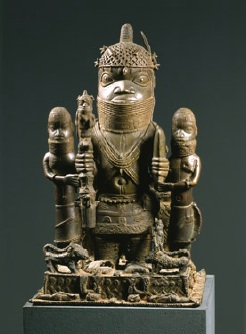Kings and Rituals from Benin (original) (raw)
Feature Sun Jul 13 2008
Last week, the press got a sneak-peek view of Benin -- Kings and Rituals: Court Arts from Nigeria, which opened July 10 at the Art Institute of Chicago. The 220 works in the exhibit span six centuries and represent a collection amassed come from several continents. The Art Institute is the only U.S. venue to host the exhibit, which runs through Sept. 21.
In addition to a luncheon, press visitors to the pre-opening event received opportunities to hobnob with Benin royalty (including a princess), mingle with African curators and observe rituals and traditions. As far as press events go, this one was pretty festive: While one man in a long robe passed around a plateful of snacks, another walked around with a bottle of Beefeater gin, pouring a shot to anyone who needed their afternoon spirit. After the meal and dessert, the crowd collected outside the exhibit entrance; a young man dressed in bright colors did the worm, while smiling women shook gourds and sang traditional songs, and reporters and other invitees snapped pictures. The princess, looking resplendent with beads woven into her hair, and her colleagues watched from their seats at the front of the room.

photo courtesy of the Art Institute of Chicago
For those who aren't geographically inclined: Benin lies in southwest Nigeria, in West Africa. The people of Benin speak and name their culture Edo. For eight centuries, the kingdom has been ruled by divine obas, or kings; the 38th and current oba is named Erediauwa. The obas historically have supported the creation of art for political and religious purposes, which makes the exhibit a visual history of sorts of the Benin kingdom. Many plaques and pieces feature traders, wartime and battles, Benin travelers, and other aspects of daily life that serve to highlight the kingdom's power and commercial activity. Major moments in Benin history, from the arrival of the Portuguese in the 15th century to the invasion of the British in 1897, are both documented and evident as stylistic changes.
For the Edo, the Art Institute's exhibit is a point of pride, many of the invited officials explained -- a way for an American audience to learn more about their culture and craftsmanship. Using brass, ivory, and coral, the artisans who created the works on display must have labored for many days or weeks to create the intricate patterns and designs featured on many of the works. Plaques often feature people and scenes in high relief, which are enhanced by low-relief impressions arranged into repetitious dot and floral background designs.
The institutions responsible for assembling and traveling the exhibit are Museum für Völkerkunde Wien--Kunsthistorisches Museum (Vienna), the National Commission for Museums and Monuments, Nigeria; the Ethnologisches Museum--Staatliche Museen zu Berlin; the Art Institute; and the Musée du Quai Branly in Paris. The Art Institute is holding a variety of education events in conjunction with the exhibit, including tours and Pattern Play, in which participants can create patterns inspired by the symbols on artwork from the exhibition. And those who wish to have a lasting reminder of the exhibit will soon be able to pick up a copy of Benin: Royal Arts of a West African Kingdom, a 40-page catalogue featuring an informative essay by curator Kathleen Bickford Berzock, from the museum gift shop. For more info, visit the exhibit's website.
About the Author:
A native of Johnstown, PA, Lauri Apple is a contender for the title, "world's most renowned bag lady," thanks to her somewhat popular (at times) website, FoundClothing. Lauri has a JD and doesn't know why, but it will take about 30 years for her to pay it off, and that worries her. Her favorite cities are Prague, Pittsburgh, Austin and Chicago. When she's not looking through people's trash, she's either painting, taking pictures, or making/thinking about making cartoons about her weird life.
